Search Result
Results for "
PROTAC-based
" in MedChemExpress (MCE) Product Catalog:
| Cat. No. |
Product Name |
Target |
Research Areas |
Chemical Structure |
-
- HY-130714
-
|
|
PROTACs
|
Cancer
|
|
TD-165 is a PROTAC-based cereblon (CRBN) degrader. TD-165 comprises a cereblon (CRBN) ligand binding group, a linker and an von Hippel-Landau (VHL) binding group .
|
-

-
- HY-129610
-
|
|
PROTACs
FKBP
|
Cancer
|
|
KB02-SLF is a PROTAC-based nuclear FKBP12 degrader (molecular glue). KB02-SLF promotes nuclear FKBP12 degradation by covalently modifying DCAF16 (E3 ligase) and can improve the durability of protein degradation in biological systems. SLF binds ubiquitin E3 ligase ligand KB02 via a linker to form KB02-SLF .
|
-
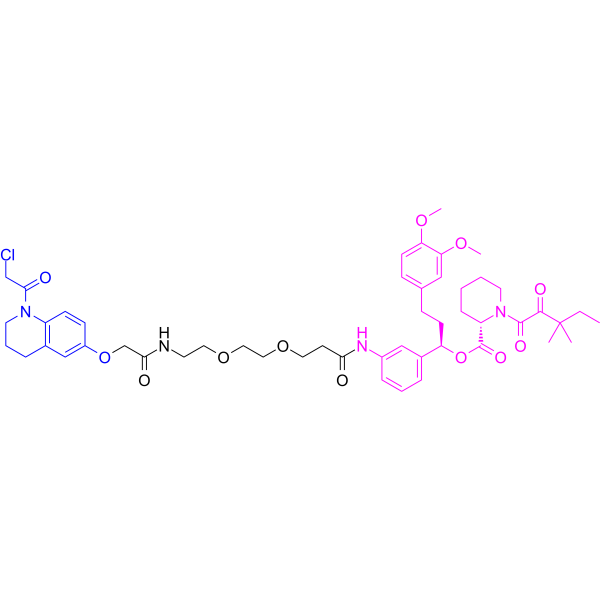
-
- HY-155398
-
-
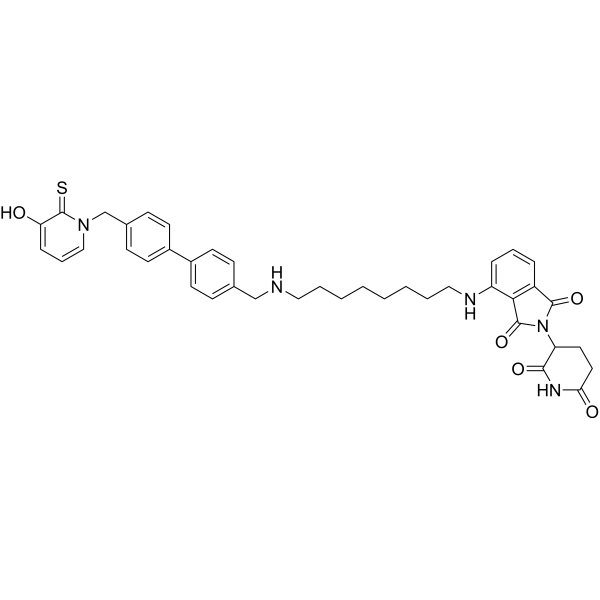
-
- HY-155397
-
-
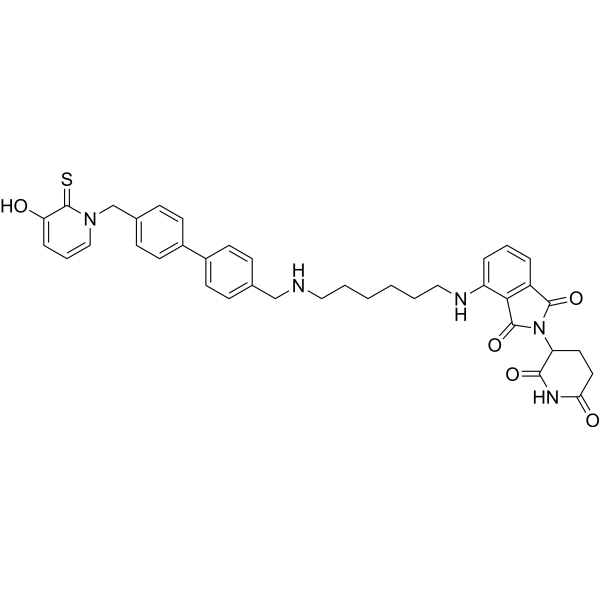
-
- HY-143882
-
|
|
PROTACs
Akt
|
Cancer
|
|
MS5033 is a potent PROTAC-based AKT (protein kinase B) degrader, with a DC50 of 430 nM in PC3 cells .
|
-
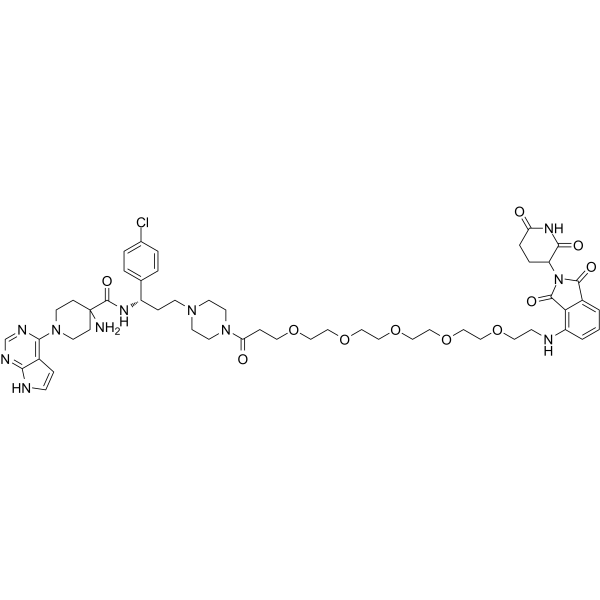
-
- HY-115568
-
|
|
PROTACs
Epigenetic Reader Domain
|
Cancer
|
|
BETd-246 is a second-generation and PROTAC-based BET bromodomain (BRD) inhibitor connected by ligands for Cereblon and BET, exhibiting superior selectivity, potency and antitumor activity .
|
-
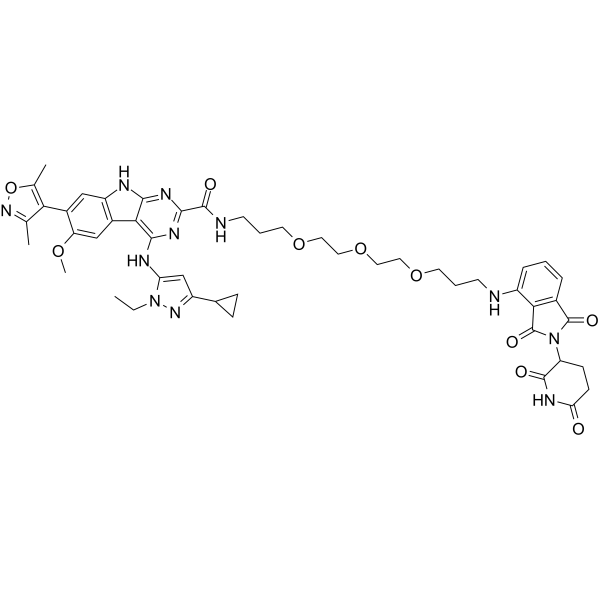
-
- HY-163152
-
-
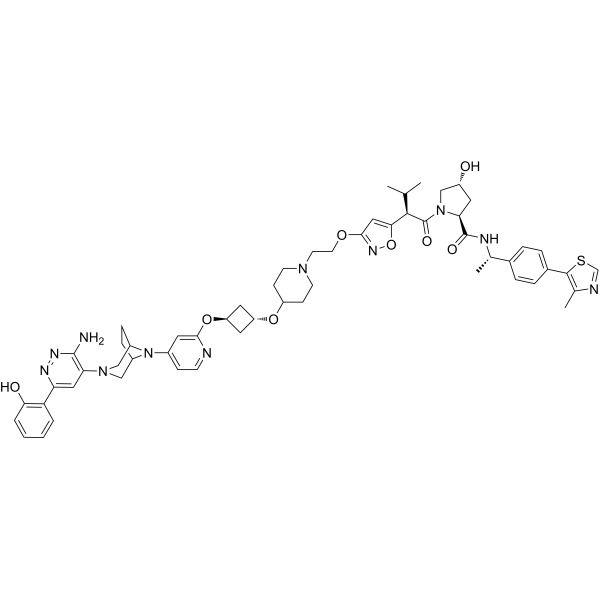
-
- HY-149236
-
-

-
- HY-155393
-
-
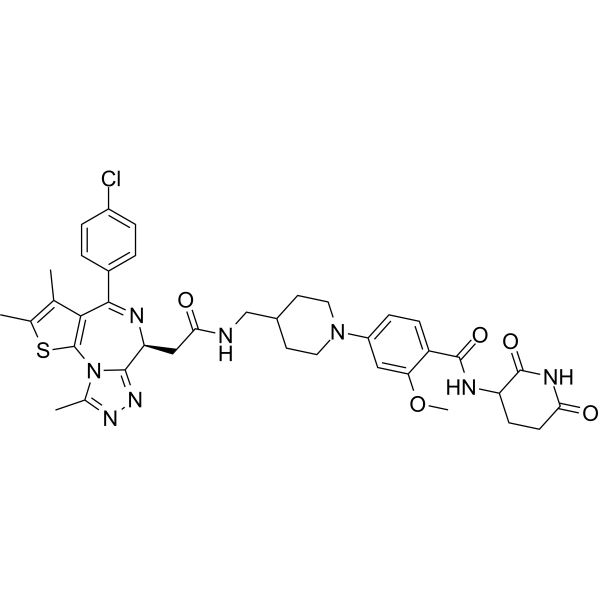
-
- HY-129180
-
|
|
PROTACs
CDK
|
Cancer
|
|
XY028-133 (example 14) is a PROTAC-based CDK4/6 degrader with anti-tumor activity, which consists of ligands for von Hippel-Lindau and CDK .
|
-

-
- HY-139707
-
-
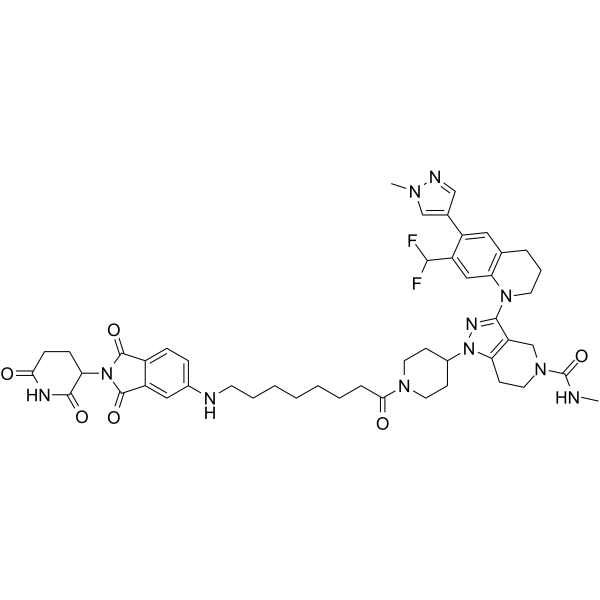
-
- HY-146231
-
|
|
PROTACs
MAP4K
|
Inflammation/Immunology
Cancer
|
|
SS47, a PROTAC-based HPK1 degrader, exerts proteasome-mediated HPK1 degradation. The degradation of HPK1 via SS47 also significantly enhances the antitumor efficacy .
|
-
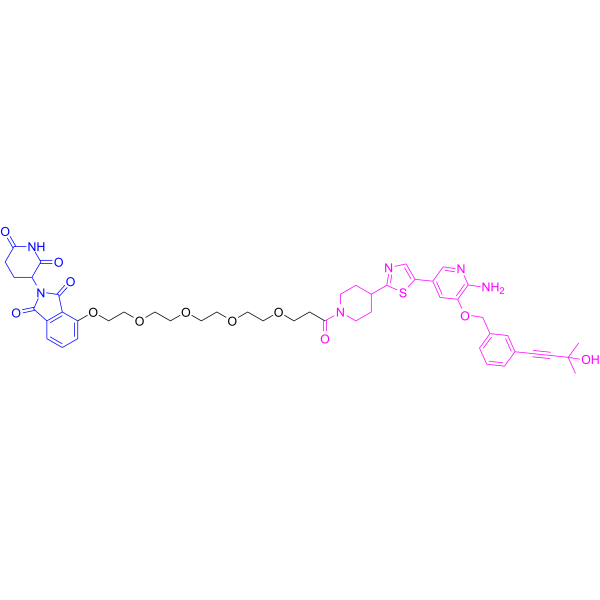
-
- HY-103634
-
|
|
PROTACs
FKBP
|
Cancer
|
|
dFKBP-1 is a potent and PROTAC-based FKBP12 degrader. dFKBP-1 incorporates the ligand SLF (HY-114872) of FKBP12, the Thalidomide based Cereblon ligand and a linker .
|
-
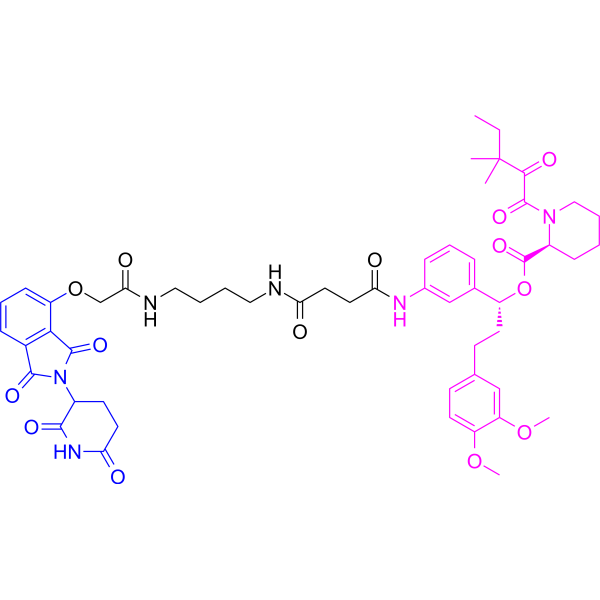
-
- HY-162450
-
|
|
PROTACs
MDM-2/p53
Apoptosis
|
Cancer
|
Antitumor agent-150 (V10), an anti-breast cancer agent, is a PROTAC-based MDM2 protein degrader (Red: Ganoderic acid A; Black: 4O-PEG linker; Blue: VHL ligand) .
|
-
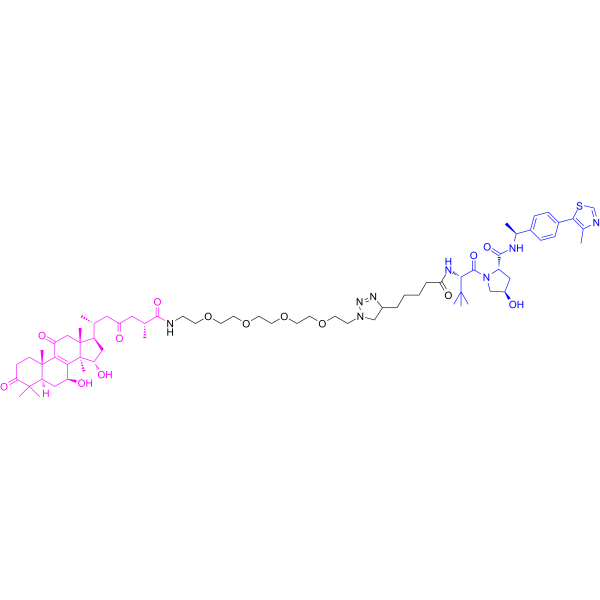
-
- HY-161157
-
|
|
PROTACs
|
Cancer
|
|
dTAG-13-NEG is a negative control of dTAG-13. dTAG-13 (HY-114421), a PROTAC-based heterobifunctional degrader, is a selective degrader of FKBP12 F36V with expression of FKBP12F36V in-frame with a protein of interest .
|
-

-
- HY-158048
-
|
|
PROTACs
STING
|
Inflammation/Immunology
|
|
UNC9036 is a PROTAC-based STING degrader, with a DC50 of 227 nM. UNC9036-mediated STING degradation is proteasome and VHL dependent (Srtucture Note: Red, STING agonist diABZI (HY-112921A); Blue, VHL ligand VH032 (HY-120217); Black, linker) .
|
-
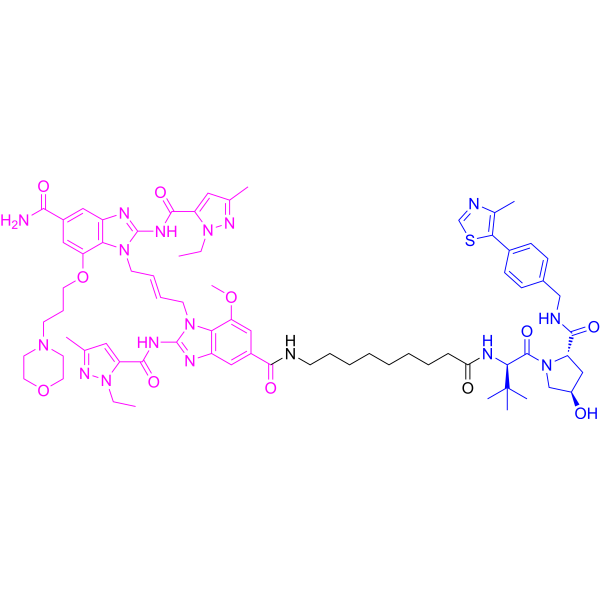
-
- HY-147219
-
|
|
PROTACs
Anaplastic lymphoma kinase (ALK)
EGFR
Apoptosis
|
Cancer
|
|
SIAIS164018 is a PROTAC-based ALK and EGFR degrader, with IC50 value of 2.5 nM and 6.6 nM for ALK and ALK G1202R, respectively. SIAIS164018 strongly inhibits cancer cells migration and invasion, causes G1 cell cycle arrest and induces apoptosis. SIAIS164018 exhibits better property than Brigatinib (HY-12857) .
|
-
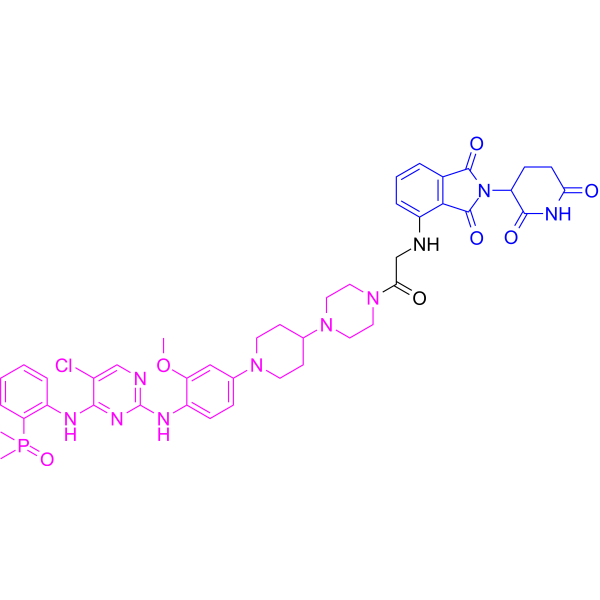
-
- HY-147219A
-
|
|
PROTACs
Anaplastic lymphoma kinase (ALK)
EGFR
Apoptosis
|
Cancer
|
|
SIAIS164018 hydrochloride is a PROTAC-based ALK and EGFR degrader, with IC50 value of 2.5 nM and 6.6 nM for ALK and ALK G1202R, respectively. SIAIS164018 hydrochloride strongly inhibits cancer cells migration and invasion, causes G1 cell cycle arrest and induces apoptosis. SIAIS164018 hydrochloride exhibits better property than Brigatinib (HY-12857) .
|
-
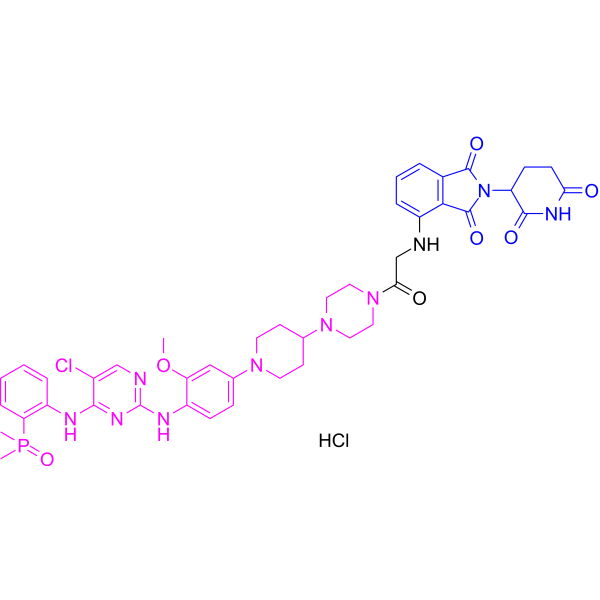
-
- HY-133120
-
|
|
PROTACs
Akt
|
Cancer
|
|
INY-03-041 is a potent, highly selective and PROTAC-based pan-AKT degrader consisting of the ATP-competitive AKT inhibitor Ipatasertib (HY-15186) conjugated to Lenalidomide (HY-A0003, Cereblon ligand). INY-03-041 inhibits AKT1, AKT2 and AKT3 with IC50s of 2.0, 6.8 and 3.5 nM, respectively .
|
-
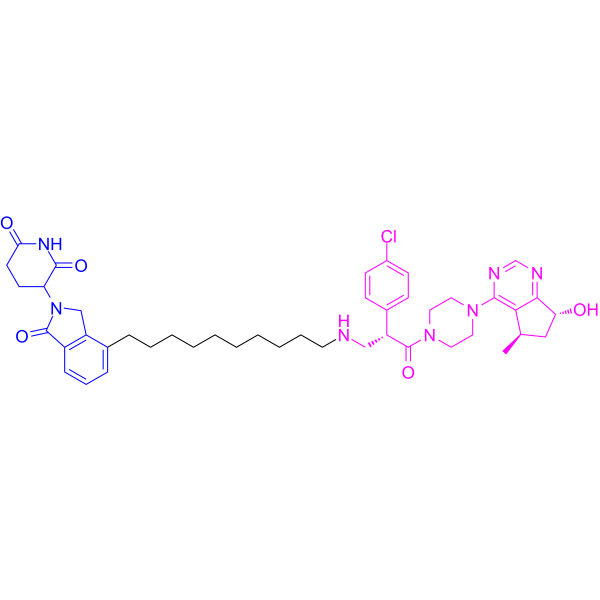
-
- HY-133120A
-
|
|
PROTACs
Akt
|
Cancer
|
|
INY-03-041 trihydrochloride is a potent, highly selective and PROTAC-based pan-AKT degrader consisting of the ATP-competitive AKT inhibitor Ipatasertib (HY-15186) conjugated to Lenalidomide (HY-A0003, Cereblon ligand). INY-03-041 trihydrochloride inhibits AKT1, AKT2 and AKT3 with IC50s of 2.0, 6.8 and 3.5 nM, respectively .
|
-
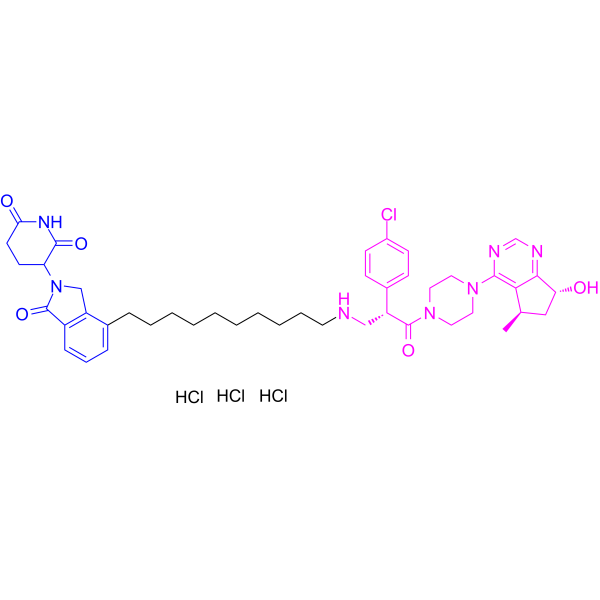
-
- HY-114421
-
|
dTAG-13
|
PROTACs
FKBP
|
Cancer
|
|
FKBP12 PROTAC dTAG-13 (dTAG-13), a PROTAC-based heterobifunctional degrader, is a selective degrader of FKBP12 F36V with expression of FKBP12F36V in-frame with a protein of interest. FKBP12 PROTAC dTAG-13 effectively engages FKBP12 F36V and CRBN, thereby selectively degrading FKBP12 F36V .
|
-
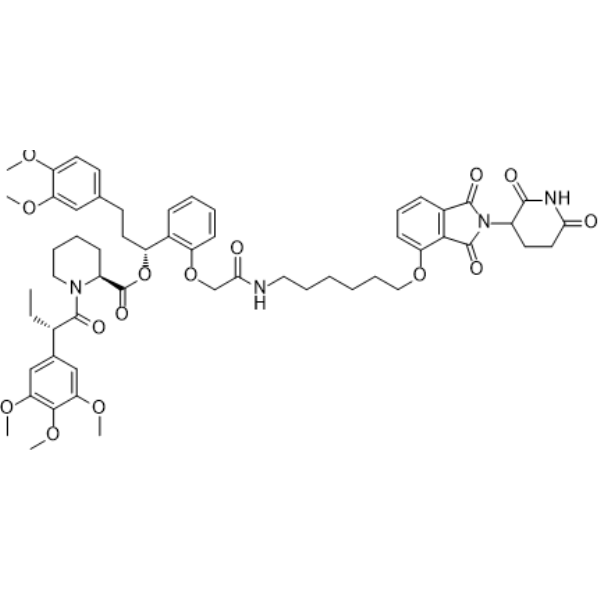
-
- HY-135382
-
|
|
PROTACs
IRAK
|
Inflammation/Immunology
Cancer
|
|
PROTAC IRAK4 degrader-2 (Compound 9) is a PROTAC-based IRAK4 degrader that affords potent IRAK4 degradation with a DC50 in peripheral blood mononuclear cells (PBMCs) cells of 151 nM. PROTAC IRAK4 degrader-2 induce a reduction of IRAK4 protein levels with a DC50 of 36 nM in PBMC cells. PROTAC IRAK4 degrader-2 also leads to the inhibition of multiple cytokines in PBMCs .
|
-
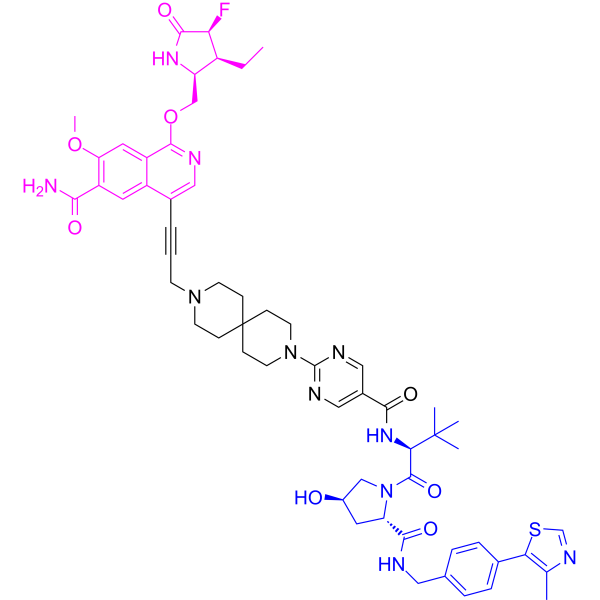
-
- HY-150251
-
|
|
STAT
PROTACs
|
Cancer
|
|
STAT3 degrader-2 is a PROTAC-based degrader of STAT3. STAT3 degrader-2 can degrade the level of total STAT3 protein. STAT3 degrader-2 can be used for the research of cancer and other diseases . STAT3 degrader-2 is a click chemistry reagent, it contains an Alkyne group and can undergo copper-catalyzed azide-alkyne cycloaddition (CuAAc) with molecules containing Azide groups.
|
-
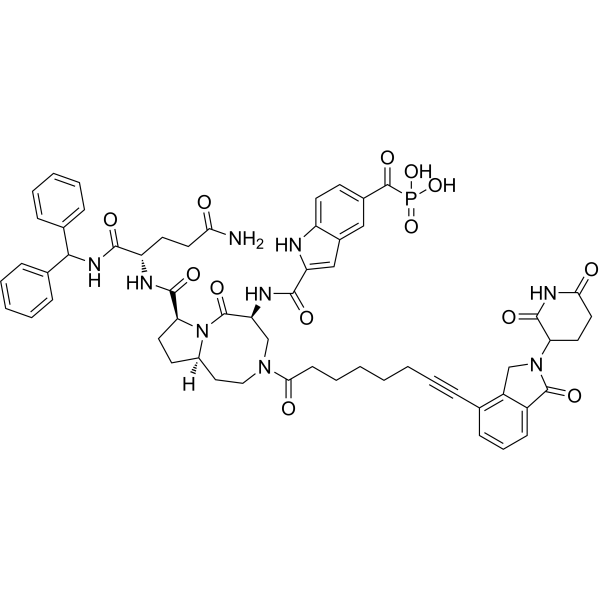
-
- HY-162412
-
|
|
PROTACs
Adrenergic Receptor
Apoptosis
|
Cancer
|
PROTAC AR/AR-V7 degrader-1 (27c) is a PROTAC-based and dual AR, AR-V7 degrader, with DC50 values of 2.67 and 2.64 μM for AR and AR-V7, respectively. PROTAC AR/AR-V7 degrader-1 (27c) induces apoptosis (Red: AR antagonist; Blue: E3 ligase ligand; Black: linker) .
|
-

-
- HY-146231A
-
|
|
MAP4K
PROTACs
|
Inflammation/Immunology
Cancer
|
|
SS47 TFA, a PROTAC-based HPK1 degrader, exerts proteasome-mediated HPK1 degradation. The degradation of HPK1 via SS47 also significantly enhances the in vivo antitumor efficacy of BCMA CAR-T cell research. HPK1, an immunosuppressive regulatory kinase, is a promising target for cancer immunotherapies . SS47 (TFA) is a click chemistry reagent, it contains an Alkyne group and can undergo copper-catalyzed azide-alkyne cycloaddition (CuAAc) with molecules containing Azide groups.
|
-
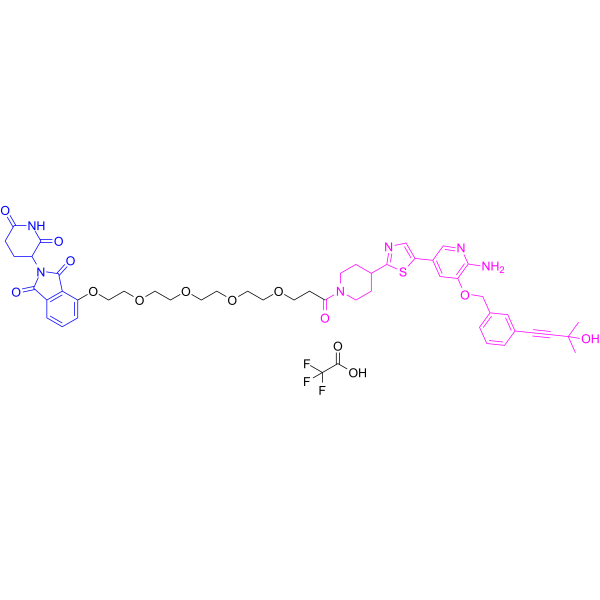
-
- HY-129917
-
|
|
PROTACs
Epigenetic Reader Domain
|
Cancer
|
|
KB02-JQ1 is a highly selective and PROTAC-based BRD4 degrader (molecular glue), but does not degrade BRD2 or BRD3. KB02-JQ1 promotes BRD4 degradation by covalently modifying DCAF16 (E3 ligase) and can improve the durability of protein degradation in biological systems. JQ1 binds ubiquitin E3 ligase ligand KB02 via a linker to form KB02-JQ1 .
|
-
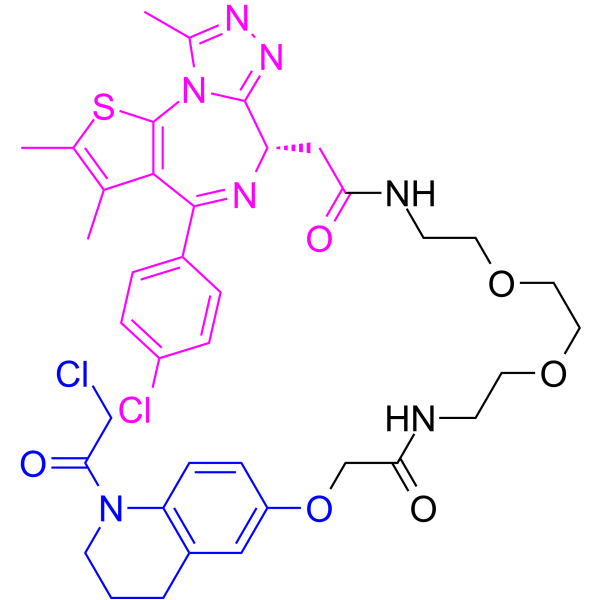
-
- HY-130985
-
|
|
PROTAC Linkers
|
Cancer
|
|
9-Decyn-1-ol is an alkyl/ether-based PROTAC linker that can be used in the synthesis of PROTACs. 9-Decyn-1-ol can be used to conjugate GDC-0068 with Lenalidomide to generate INY-03-041. INY-03-041 is a potent, highly selective and PROTAC-based pan-Akt degrader. INY-03-041 inhibits Akt1, Akt2 and Akt3 with IC50s of 2.0 nM, 6.8 nM and 3.5 nM, respectively . 9-Decyn-1-ol is a click chemistry reagent, it contains an Alkyne group and can undergo copper-catalyzed azide-alkyne cycloaddition (CuAAc) with molecules containing Azide groups.
|
-
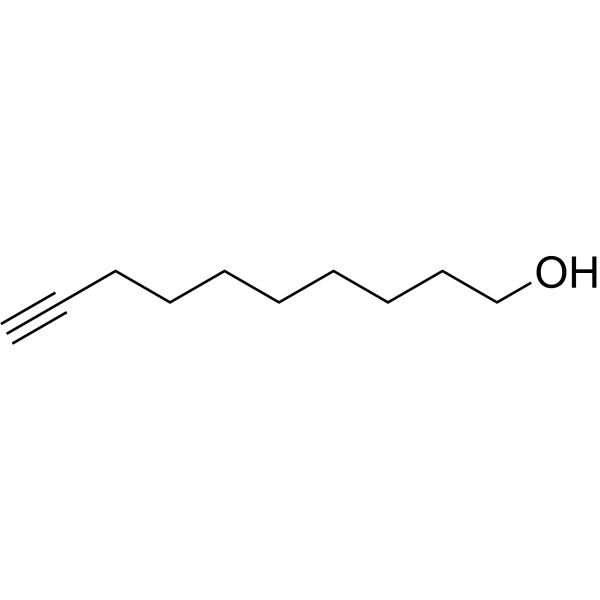
-
- HY-157334
-
|
|
Casein Kinase
|
Cancer
|
|
DEG-77, a PROTAC based IKZF2 and CK1α degrader, possesses suitable pharmacokinetic properties, solubility, and selectivity for in vivo studies (t1/2=8h) .
|
-

-
- HY-156814
-
|
|
Hedgehog
|
Cancer
|
|
HPP-9 is a Proteolysis-Targeting Chimeras (PROTACs) based on Hedgehog Pathway Inhibitor-1 (HPI-1), with the pIC50 of 6.71, that can degrade BET bromodomains. HPP-9 has antitumor activity [1[.
|
-
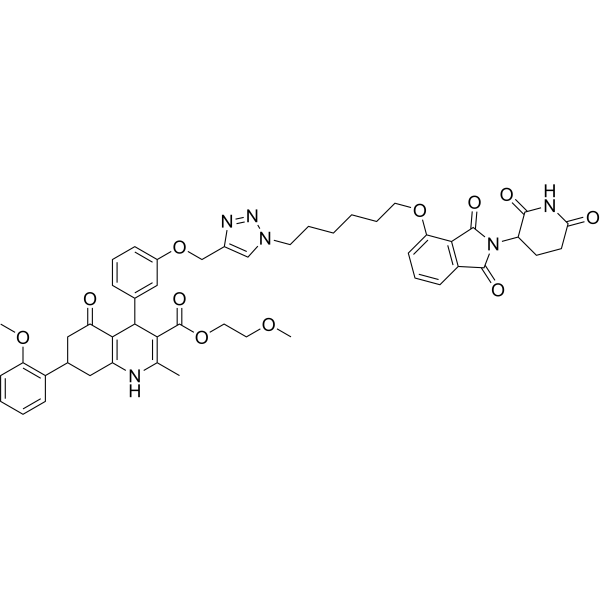
-
- HY-114405
-
|
|
PROTACs
p38 MAPK
Autophagy
|
Cancer
|
|
SJFδ is a 10-atom linker PROTAC based on von Hippel-Lindau ligand. SJFδ degrades p38δ with a DC50 of 46.17 nM, but does not degrade p38α, p38β, or p38γ .
|
-

-
- HY-155684
-
|
|
PROTACs
VEGFR
PDGFR
Ephrin Receptor
|
Cancer
|
|
SA-PA is an intracellular self-assembled PROTAC based on azide and alkyne. SA-PA is able to selectively degrade VEGFR-2, PDGFR-β and EphB4 proteins in U87 cells. SA-PA can be converted to PROTAC in situ by click reaction with the help of endogenous copper in tumor tissues .
|
-

-
- HY-155685
-
|
|
PROTACs
VEGFR
Ephrin Receptor
Apoptosis
|
Cancer
|
|
SA-VA is an intracellular self-assembled PROTAC based on azide and alkyne. SA-VA is able to selectively degrade VEGFR-2 and EphB4 proteins in U87 cells. SA-VA can be converted to PROTAC in situ by click reaction with the help of endogenous copper in tumor tissues. SA-VA promotes apoptosis and blocks cells in S phase .
|
-
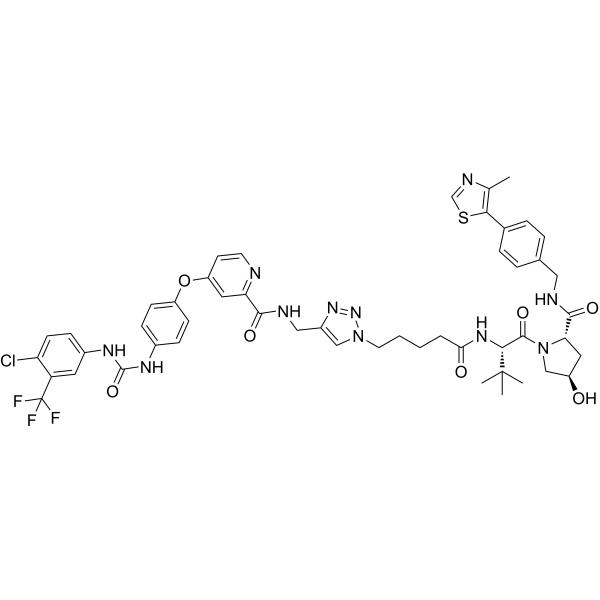
-
- HY-114404
-
|
|
PROTACs
p38 MAPK
Autophagy
|
Cancer
|
|
SJFα is a 13-atom linker PROTAC based on von Hippel-Lindau ligand. SJFα degrades p38α with a DC50 of 7.16 nM, but is far less effective at degrading p38δ (DC50=299 nM) and does not degrade the other p38 isoforms (β and γ) at concentrations up to 2.5 µM .
|
-
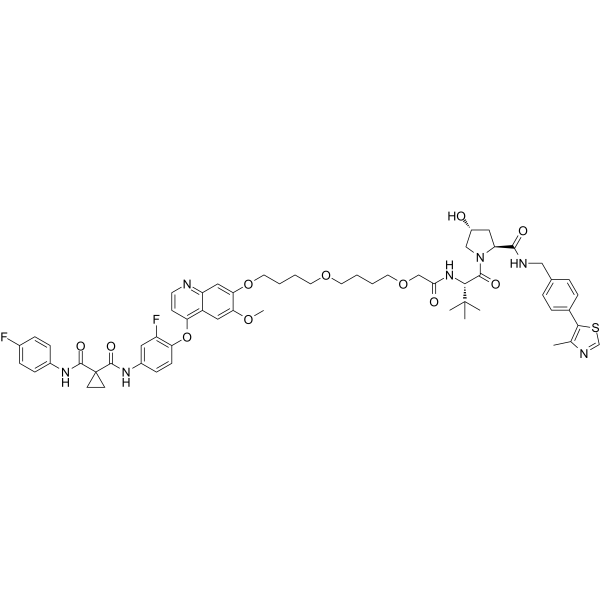
-
- HY-125877
-
|
|
PROTACs
Bcl-2 Family
|
Cancer
|
|
PROTAC Mcl1 degrader-1 (compound C3), a proteolysis targeting chimera (PROTAC) based on Cereblon ligand, is a potently and selectively Mcl-1 (Bcl-2 family member) inhibitor with an IC50 of 0.78 μM. PROTAC Mcl1 degrader-1 inhibits Bcl-2 with an IC50 of 0.54 μM .
|
-
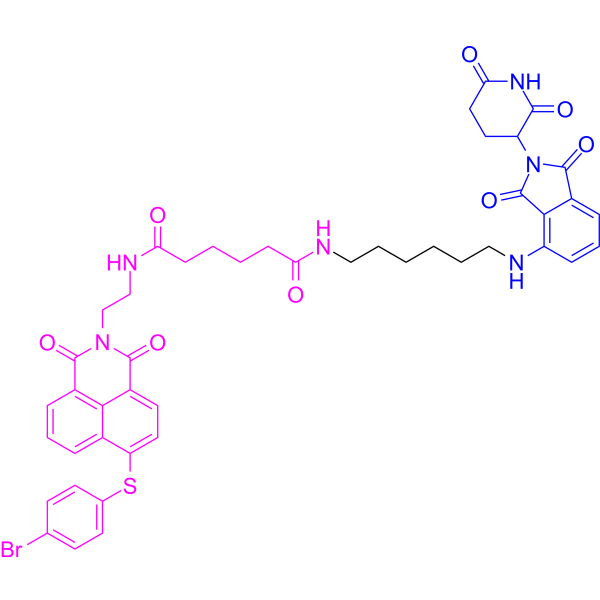
-
- HY-146022
-
|
|
PROTACs
Anaplastic lymphoma kinase (ALK)
|
Cancer
|
|
SIAIS117 is a potent Brigatinib-PROTAC degrader. SIAIS117 is a ALK PROTAC based on Brigatinib and VHL-1 conjunction. SIAIS117 can degrade ALK G1202R point mutation effectively. SIAIS117 blocks the growth of SR and H2228 cancer cell lines. SIAIS117 has the potentially anti-proliferation ability of small cell lung cancer .
|
-
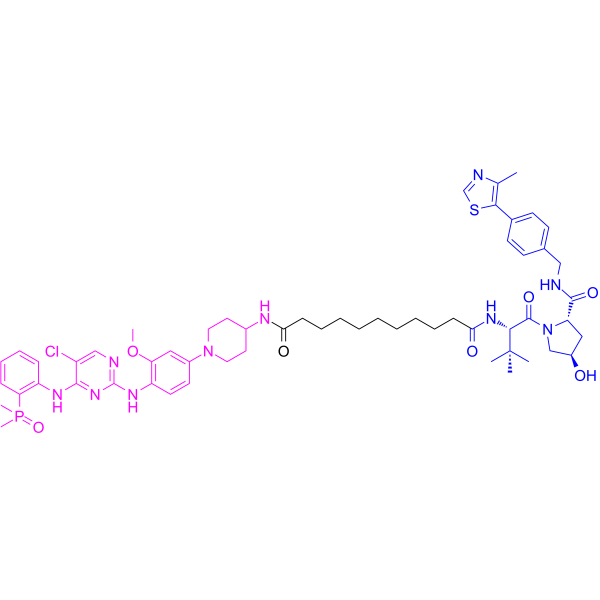
-
- HY-W584527
-
|
|
Ligands for E3 Ligase
|
Cancer
|
|
VH032 analogue-1 is a VH032 (HY-120217) analog that acts as a ligand for VHL, recruiting von Hippel-Lindau (VHL) protein. VH032 analogue-1 will remove the protective group under acidic conditions and be directly used for PROTAC molecular synthesis. VH032 analogue-1 is a key intermediate in the synthesis of PROTACs based on VHL ligands.
|
-
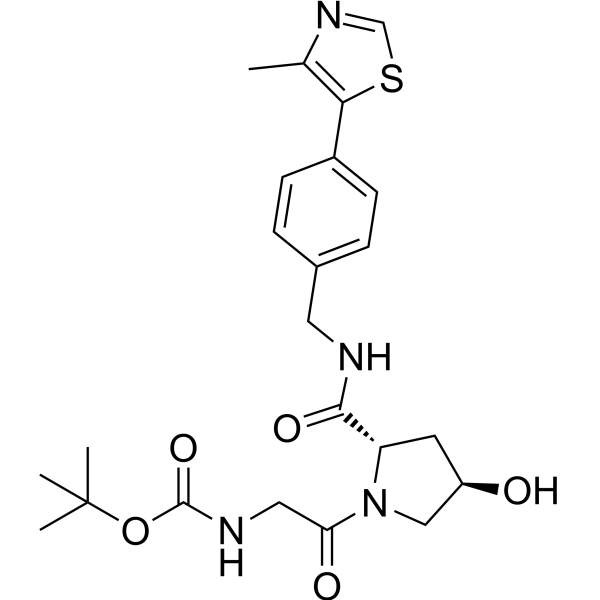
-
- HY-W584528
-
|
|
Ligands for E3 Ligase
|
Cancer
|
|
VH032 analogue-2 is a VH032 (HY-120217) analog that acts as a ligand for VHL, recruiting von Hippel-Lindau (VHL) protein. VH032 analogue-2 will remove the protective group under acidic conditions, and can be directly used for the synthesis of PROTAC molecules. VH032 analogue-2 is a key intermediate for the synthesis of PROTACs based on VHL ligands.
|
-
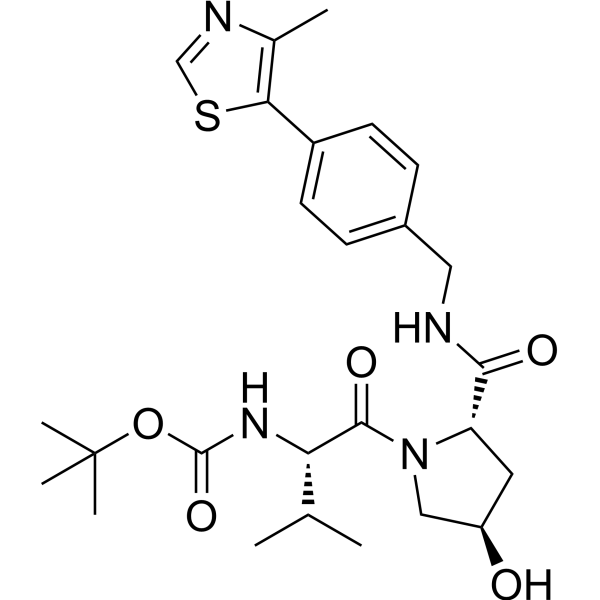
-
- HY-100972
-
ARV-771
Maximum Cited Publications
21 Publications Verification
|
PROTACs
Epigenetic Reader Domain
|
Cancer
|
|
ARV-771 is a potent BET PROTAC based on E3 ligase von Hippel-Lindau with Kds of 34 nM, 4.7 nM, 8.3 nM, 7.6 nM, 9.6 nM, and 7.6 nM for BRD2(1), BRD2(2), BRD3(1), BRD3(2), BRD4(1), and BRD4(2), respectively .
|
-
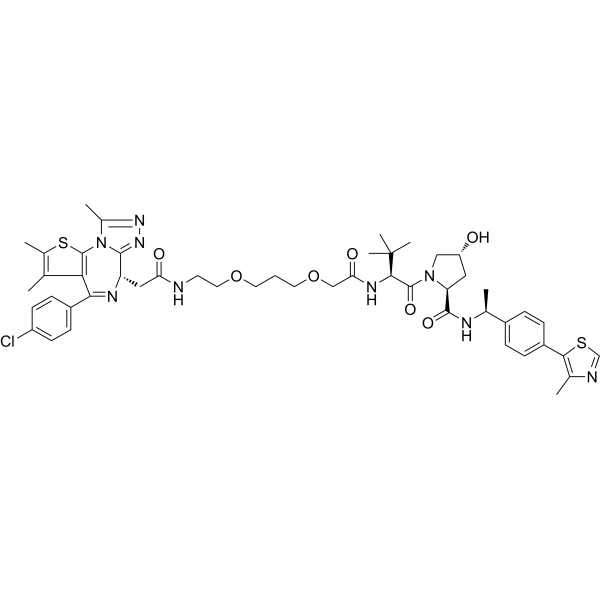
-
- HY-111866
-
|
|
PROTACs
RIP kinase
|
Metabolic Disease
Cancer
|
|
PROTAC RIPK degraders -2 is a non-peptide PROTAC based on von Hippel-Lindau and targets serine-threonine kinase RIPK2, which is highly selective to the degradation of RIPK2. PROTAC RIPK degrader-2 acts as an activator to increase cell death and activate ion channels in cancer cells. PROTAC RIPK degrader-2 also can inhibit protein interactions, such as receptors and ligands, involved in a variety of diseases, such as cancer and diabetes .
|
-

-
- HY-W584525
-
|
|
Ligands for E3 Ligase
|
Cancer
|
|
VH032-NH-CO-CH2-NHBoc is a Boc-modified VH032 (HY-120217) that acts as a ligand for VHL to recruit von Hippel-Lindau (VHL) proteins. VH032-NH-CO-CH2-NHBoc will remove the Boc protection under acidic conditions, and connect with the target protein ligand through a linker to form a PROTAC molecule, which is a key intermediate for the synthesis of PROTAC based on VHL ligand.
|
-
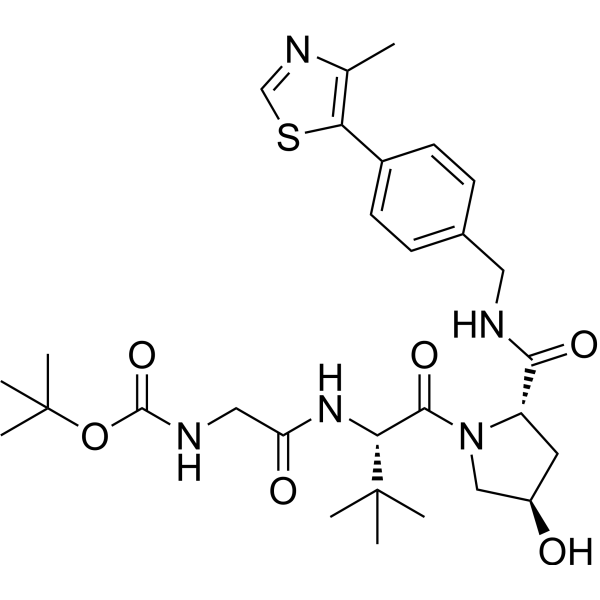
-
- HY-W584534
-
|
|
Ligands for E3 Ligase
|
Cancer
|
|
VH032-CH2-Boc is a Boc-modified VH032 (HY-120217) that serves as a ligand for VHL and recruits von Hippel-Lindau (VHL) proteins. VH032-CH2-Boc will remove the protecting group under acidic conditions and be directly used in PROTAC molecule synthesis. VH032-CH2-Boc is a key intermediate in the synthesis of PROTAC based on VHL ligand.
|
-

-
- HY-W584535
-
|
|
Ligands for E3 Ligase
|
Cancer
|
|
VH032-C3-Boc is a Boc-modified VH032 (HY-120217) that serves as a ligand for VHL and recruits von Hippel-Lindau (VHL) proteins. VH032-C3-Boc will remove the protective group under acidic conditions and be directly used for PROTAC molecular synthesis. VH032-C3-Boc is a key intermediate for the synthesis of PROTACs based on VHL ligands.
|
-
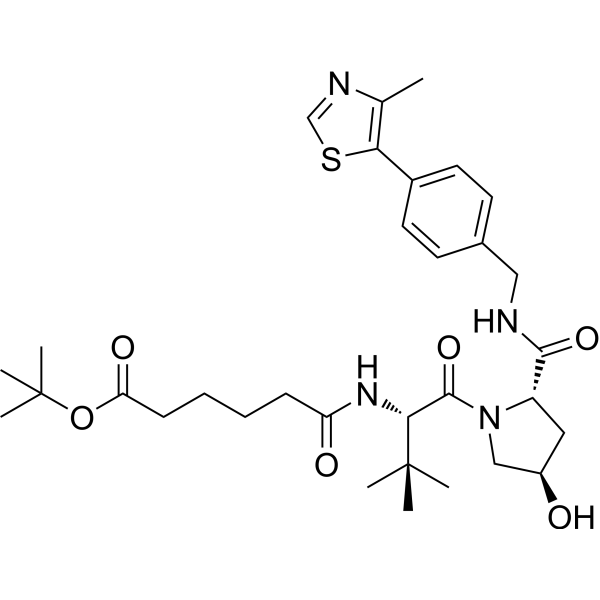
-
- HY-W584529
-
|
|
Ligands for E3 Ligase
|
Cancer
|
|
VH032-C2-NH-Boc is a Boc-modified VH032 (HY-120217) that acts as a ligand for VHL and recruits von Hippel-Lindau (VHL) proteins. VH032-C2-NH-Boc will remove the protecting group under acidic conditions, and can be directly used for the synthesis of PROTAC molecules. VH032-C2-NH-Boc is a key intermediate for the synthesis of PROTACs based on VHL ligands.
|
-
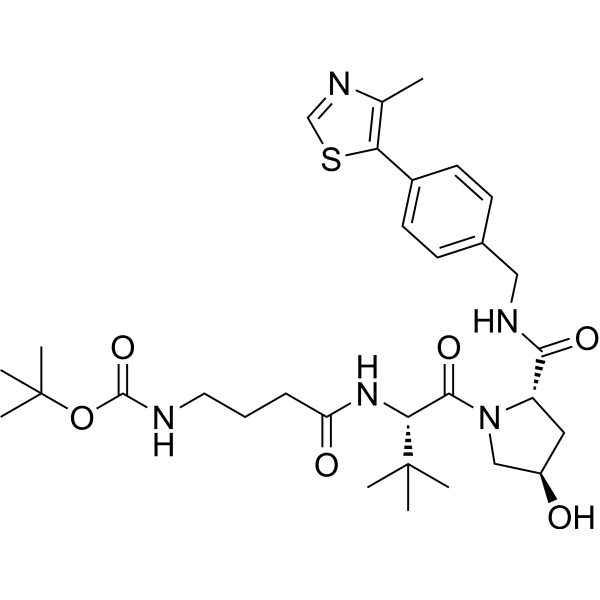
-
- HY-W584530
-
|
|
Ligands for E3 Ligase
|
Cancer
|
|
VH032-C4-NH-Boc is a Boc-modified VH032 (HY-120217) that acts as a ligand for VHL to recruit von Hippel-Lindau (VHL) proteins. VH032-C4-NH-Boc will remove the protecting group under acidic conditions and be directly used in PROTAC molecule synthesis. VH032-C4-NH-Boc is a key intermediate in the synthesis of PROTAC based on VHL ligand.
|
-
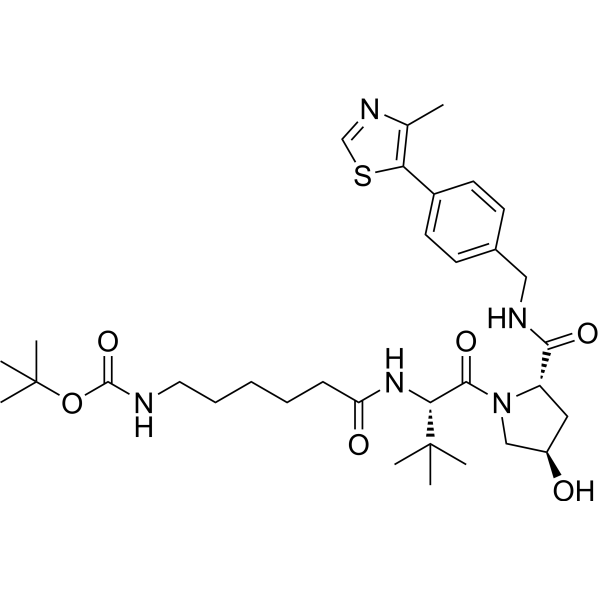
-
- HY-W584531
-
|
|
Ligands for E3 Ligase
|
Cancer
|
|
VH032-C6-NH-Boc is a Boc-modified VH032 (HY-120217) that serves as a ligand for VHL and recruits von Hippel-Lindau (VHL) proteins. VH032-C6-NH-Boc will remove the protecting group under acidic conditions and be directly used in PROTAC molecule synthesis. VH032-C6-NH-Boc is a key intermediate in the synthesis of PROTAC based on VHL ligand.
|
-

-
- HY-W584533
-
|
|
Ligands for E3 Ligase
|
Cancer
|
|
VH032-PEG2-NH-BOC is a Boc-modified VH032 (HY-120217) that serves as a ligand for VHL and recruits von Hippel-Lindau (VHL) proteins. VH032-PEG2-NH-BOC will remove the protecting group under acidic conditions and be directly used for PROTAC molecule synthesis. VH032-PEG2-NH-BOC is a key intermediate in the synthesis of PROTAC based on VHL ligand.
|
-

-
- HY-160506
-
|
|
PROTACs
c-Met/HGFR
Apoptosis
|
|
|
PRO-6E is an oral active PROTAC based on Cereblon ligand, and induces the degradation of MET with maximum degradation of 81.9% at 1 μM in MKN-45 cells. PRO-6E inhibits tumor growth in vivo and in vitro. PRO-6E induces cell apoptosis and induces cell arrest (Sturcture Note:(Blue: Cereblon ligand (HY-103596), Black: linker;Pink: ALK/c-Met inhibitor Crizotinib (HY-50878)) .
|
-

-
- HY-W584532
-
|
|
Ligands for E3 Ligase
|
Cancer
|
|
VH032-O-C2-NH-Boc is a Boc-modified VH032 (HY-120217) that serves as a ligand for VHL and recruits von Hippel-Lindau (VHL) proteins. VH032-O-C2-NH-Boc will remove the protecting group under acidic conditions and can be directly used in PROTAC molecule synthesis. VH032-O-C2-NH-Boc is a key intermediate in the synthesis of PROTAC based on VHL ligand.
|
-
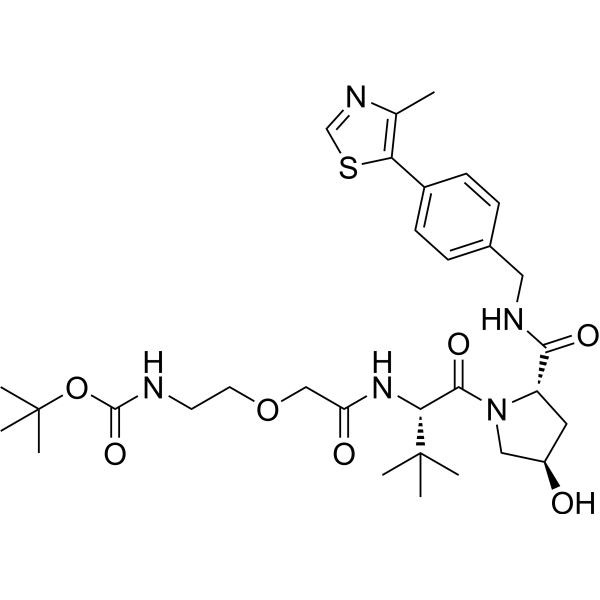
-
- HY-125876
-
|
|
PROTACs
Bcl-2 Family
|
Cancer
|
|
PROTAC Bcl2 degrader-1 (Compound C5) is a PROTAC based on Cereblon ligand, which potently and selectively induces the degradation of Bcl-2 (IC50, 4.94 μM; DC50, 3.0 μM) and Mcl-1 (IC50, 11.81 μM) by introducing the E3 ligase cereblon (CRBN)-binding ligand pomalidomide to Mcl-1/Bcl-2 dual inhibitor Nap-1 (Blue: CRBN ligand, Black: linker;Pink: Mcl-1/Bcl-2 inhibitor, Nap-1).
|
-
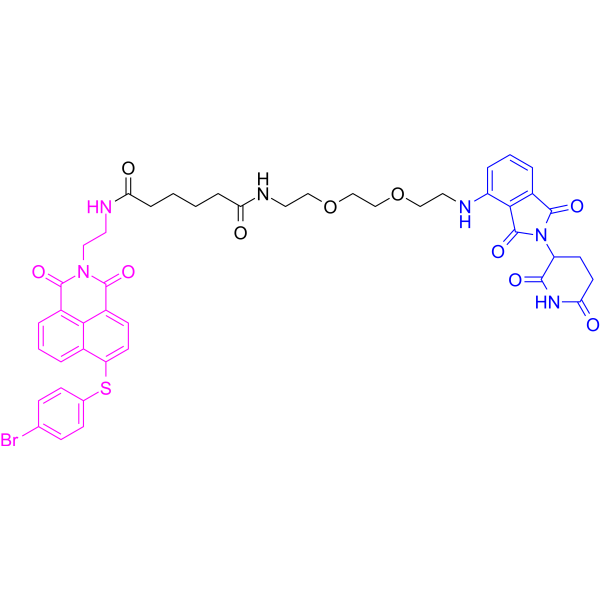
-
- HY-131183
-
|
|
PROTACs
PD-1/PD-L1
|
Inflammation/Immunology
|
|
PROTAC PD-1/PD-L1 degrader-1, a PD-1/PD-L1 PROTAC based on Cereblon E3 ligand, inhibits PD-1/PD-L1 interaction with an IC50 of 39.2 nM. PROTAC PD-1/PD-L1 degrader-1 significantly restores the immunity repressed in a co-culture model of Hep3B/OS-8/hPD-L1 and CD3 T cells. PROTAC PD-1/PD-L1 degrader-1 moderately reduces the protein levels of PD-L1 in a lysosome-dependent manner .
|
-

| Cat. No. |
Product Name |
|
Classification |
-
- HY-130985
-
|
|
|
Alkynes
PROTAC Synthesis
|
|
9-Decyn-1-ol is an alkyl/ether-based PROTAC linker that can be used in the synthesis of PROTACs. 9-Decyn-1-ol can be used to conjugate GDC-0068 with Lenalidomide to generate INY-03-041. INY-03-041 is a potent, highly selective and PROTAC-based pan-Akt degrader. INY-03-041 inhibits Akt1, Akt2 and Akt3 with IC50s of 2.0 nM, 6.8 nM and 3.5 nM, respectively . 9-Decyn-1-ol is a click chemistry reagent, it contains an Alkyne group and can undergo copper-catalyzed azide-alkyne cycloaddition (CuAAc) with molecules containing Azide groups.
|
Your information is safe with us. * Required Fields.
Inquiry Information
- Product Name:
- Cat. No.:
- Quantity:
- MCE Japan Authorized Agent:



























































